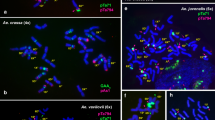Abstract.
Six polyploid Aegilops species containing the D genome were studied by C-banding and fluorescence in situ hybridization (FISH) using clones pTa71 (18S-5.8S-26S rDNA), pTa794 (5S rDNA), and pAs1 (non-coding repetitive DNA sequence) as probes. The C-banding and pAs1-FISH patterns of Ae. cylindrica chromosomes were identical to those of the parental species. However, inactivation of the NOR on chromosome 5D with a simultaneous decrease in the size of the pTa71-FISH site was observed. The Nv and Dv genomes of Ae. ventricosa were somewhat modified as compared with the N genome of Ae. uniaristata and the D genome of Ae. tauschii. Modifications included minor changes in the C-banding and pAs1-FISH patterns, complete deletion of the NOR on chromosome 5Dv, and the loss of several minor 18S-5.8S-26S rDNA loci on Nv genome chromosomes. According to C-banding and FISH analyses, the Dcr1 genome of Ae. crassa is more similar to the Dv genome of Ae. ventricosa than to the D genome of Ae. tauschii. Mapping of the 18S-5.8S-26S rDNA and 5S rDNA loci by multicolor FISH suggests that the second (Xcr) genome of tetraploid Ae. crassa is a derivative of the S genome (section Emarginata of the Sitopsis group). Both genomes of Ae. crassa were significantly modified as the result of chromosomal rearrangements and redistribution of highly repetitive DNA sequences. Hexaploid Ae. crassa and Ae. vavilovii arose from the hybridization of chromosomal type N of tetraploid Ae. crassa with Ae. tauschii and Ae. searsii, respectively. Chromosomal type T1 of tetraploid Ae. crassa and Ae. umbellulata were the ancestral forms of Ae. juvenalis. The high level of genome modification in Ae. juvenalis indicates that it is the oldest hexaploid species in this group. The occurrence of hexaploid Ae. crassa was accompanied by a species-specific translocation between chromosomes 4Dcr1 and 7Xcr. No chromosome changes relative to the parental species were detected in Ae. vavilovii, however, its intraspecific diversity was accompanied by a translocation between chromosomes 3Xcr and 3Dcr1.
Similar content being viewed by others

Author information
Authors and Affiliations
Additional information
Received July 24, 2001 Accepted October 1, 2001
Rights and permissions
About this article
Cite this article
Badaeva, E., Amosova, A., Muravenko, O. et al. Genome differentiation in Aegilops. 3. Evolution of the D-genome cluster. Plant Syst. Evol. 231, 163–190 (2002). https://doi.org/10.1007/s006060200018
Issue Date:
DOI: https://doi.org/10.1007/s006060200018



